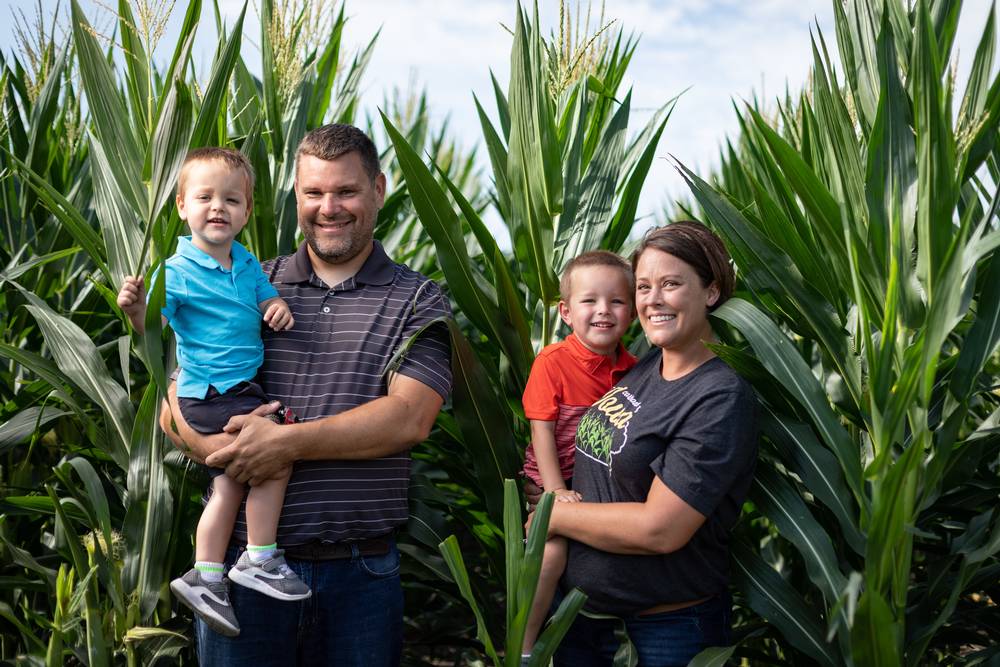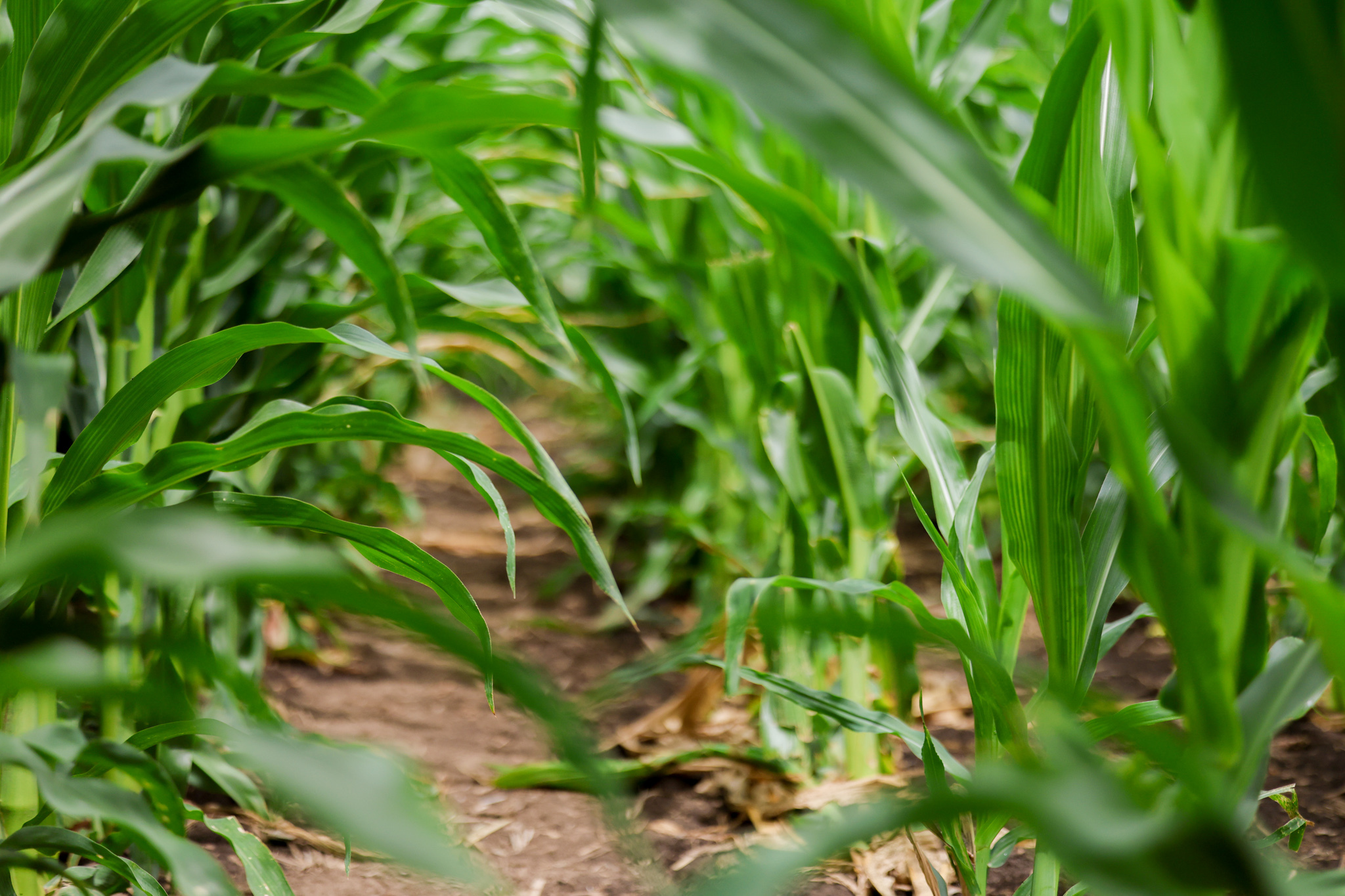Corn Facts and Fun
Iowa grows more corn than any other state and even most countries! Needless to say, it’s a crop that plays a very big role in the state of Iowa. Have questions about corn and how it impacts you? From how corn is grown to how it’s used, explore our FAQ on all things Iowa corn!
Iowa’s Corn Production
Iowa farmers produced around 2.4 billion bushels of corn for grain and harvested 12.9 million acres according to the U.S. Department of Agricultural Statistics Service.
Only one percent of corn planted in the United States is sweet corn. 99 percent of corn grown in Iowa is “Field Corn”. When Iowa’s corn farmers deliver corn from the field, it’s “Field Corn”. Not the delicious sweet corn you might enjoy on the cob or in a can.
Field corn is the classic big ears of yellow dented corn you see dried and harvested in the fall. It’s called “dent corn” because of the distinctive dent that forms on the kernel as the corn dries.
While a small portion of “Field Corn” is processed for use as corn cereal, corn starch, corn oil, corn syrup and nearly 4,000 other products for human consumption, it is primarily used for livestock feed, ethanol production and manufactured goods. It’s considered a grain.
Sweet corn is what people purchase fresh, frozen or canned for eating. It’s consumed as a vegetable. Unlike “Field Corn”, which is harvested when the kernels are dry and fully mature, sweet corn is picked when immature.
Iowa has been the king of corn for almost two decades. In an average year, Iowa produces more corn than most COUNTRIES! Seriously, Iowa grows about three times as much corn as a country like Mexico. And Mexico is huge! Just goes to show Iowa grows a substantial amount of corn. We like to say, you might think Iowa just grows corn, but the truth is corn grows Iowa!
Corn has been the top crop in Iowa for more than 150 years running! And that’s not because Iowa farmers just can’t think of anything better to grow. It’s because Iowa is the best place on the planet to grow corn.
- Iowa has a growing season that is long enough and warm enough to suit corn production.
- Iowa usually receives enough rain to support healthy corn production.
- Iowa has deep, rich soils that suit corn’s needs.
- Iowa also produces lots of livestock whose waste includes nutrients that are key to fertilizing fields for better corn production.
- A wide variety of corn hybrids are available that do especially well in Iowa’s environment.
Iowa has approximately 86,900 farms. More than 97 percent of those farms are owned by farm families.
Iowa ranks number one in producing corn, hogs, eggs, ethanol and Dry Distillers Grain Solubles (DDGS) which serve as a premium source of protein for livestock. It also ranks among the top three in soybeans and fourth in beef cattle.
Planting Corn
Corn is planted when the soil is warm enough to germinate the seeds but not so early that the young plants are likely to be damaged by frost.
In Iowa, this can be in early April for the state’s southern counties, but it can be several weeks later for the state’s northern counties.
Corn grows on every continent except Antarctica.
Most corn is grown in middle latitudes (between 30 and 45 degrees), about equal to the area north of New Orleans and south of Montana in the Northern Hemisphere.
Officially, one acre is 4,840 square yards or 43,560 square feet. That’s about the size of a standard football field.
Iowa corn growers farmers grow an average of 200 bushels per acre. Nationally, the average is 175 bushels per acre.
Harvesting Corn
In Iowa, some farmers begin harvesting corn by mid-September, though most of the harvest is takes place in October.
In a cool year, when the corn matures more slowly, much of Iowa’s crop isn’t harvested until November.
Harvest times can vary a great deal because different corn hybrids take different lengths of time to mature. Even when plants are physically mature, farmers might wait to harvest them until corn kernels have dried further so that the corn can be stored for longer periods of time.
A bushel began as a measurement of volume, but the accepted standard for a bushel of corn is now measured in weight (56 pounds).
This weight is specifically for shelled corn (after the husks and cobs are removed).
Think of it as about the size of a large bag of dog food or laundry basket.
Modern combines strip the husks off each ear and remove the kernels from the ears as part of the harvesting process. The combine spreads the husks and cobs back onto the field as it moves but keeps the grain in a holding tank until it can be unloaded into a truck.
In the field, the cobs and husks are still valuable because they help maintain good soil fertility and structure, just as compost and mulch do in home gardens.
About the Corn Plant
The first corn plants seem to have appeared in Mexico, having descended from a plant called teosinte. The earliest known ears of corn were tiny – only a few inches long. Millenniums of breeding, first by Native Americans, then by early pilgrims and modern scientists, have resulted in bigger, fuller ears of corn. So be thankful the next time you butter up a big, delicious ear of sweet corn.
Different corn plants have different numbers of ears, but much of the field corn grown in Iowa is bred to develop just one large ear rather than several incomplete ears. This approach usually yields better total production.
The number of kernels per ear can vary from 500 to about 1,200. A typical ear has about 800 kernels, according to corn experts. Imagine how many kernels are found in an acre of corn!
A typical corn plant can be anywhere from five feet to 12 feet tall. That’s over a story high! Under good growing conditions in Iowa, plants are commonly about eight feet tall by midsummer. A healthy corn plant’s root system will reach about 6.5 feet into the ground!
The silks on corn are essential for pollen from the tassels to fertilize the plant. Each silk will convey pollen to one site on a developing ear of corn, making it possible for that site to develop into a kernel of corn. If it’s too hot in the summer, the silks can dry out before all the sites on a corn cob are fertilized. As a result, there will be gaps on that ear of corn where no kernels developed because they weren’t fertilized.
Uses for Corn
The great thing about corn is that it provides:
- A renewable, environmentally-friendly fuel source (ethanol)
- Animal feed for livestock which is important to our food supply
- Exports supplying the world with corn and corn products which boosts our economy
- Food ingredients necessary for preparing many of our favorite meals
- Bio-based, renewable materials for industrial uses such as bioplastics
Iowa leads the nation in ethanol production, with 62 percent (1.6 billion bushels) of the corn grown in Iowa going to create nearly 30 percent of all American ethanol.
Iowa livestock consume around 370 million bushel or 15 percent of Iowa corn went directly into livestock feed. In livestock feeding, one bushel of corn converts to about 8 pounds of beef, 15.6 pounds of pork or 21.6 pounds of chicken.
One bushel of corn produces 17 pounds of DDGS as well as 2.8 gallons of ethanol.
Corn is in more than 4,000 grocery store items. A few examples include shampoo, toothpaste, chewing gum, marshmallows, crayons and paper.
Iowa livestock consume around 370 million bushel or 15 percent of Iowa corn went directly into livestock feed. In livestock feeding, one bushel of corn converts to about 8 pounds of beef, 15.6 pounds of pork or 21.6 pounds of chicken.
One bushel of corn can produce about 2.8 gallons of ethanol, and the process also yields about 17 pounds of a high-protein animal feed known as dried distillers grains with solubles (DDGS). Corn and ethanol production are now so efficient that it takes less energy to grow the crop and process it than the amount of energy in the ethanol itself.
Corn ingredients can be found in almost 4,000 everyday products – like lipstick, paper, plastic water bottles, tires, crayons and beer. That doesn’t include all the meat, dairy and poultry products that depend on corn for livestock feed.
Humans have also been consuming genetically modified or bioengineered foods since 1996. Hundreds of scientific studies have confirmed the safety of these biotechnology products. In fact in the United States, alone, 9 billion food-producing animals are produced annually, with 95 percent of them consuming feed that contains bioengineered ingredients.

Iowa Corn Fun for Kids
Add a little color to corn with our coloring sheets, plus explore other educational resources.

